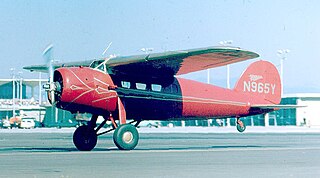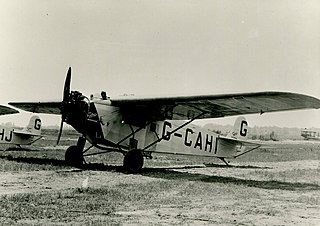
The Lockheed Vega is an American five- to seven-seat high-wing monoplane airliner built by the Lockheed Corporation starting in 1927. It became famous for its use by a number of record-breaking pilots who were attracted to its high speed and long range. Amelia Earhart became the first woman to fly solo across the Atlantic Ocean in one, and Wiley Post used his to prove the existence of the jet stream after flying around the world twice.

The Fokker E.V was a German parasol-monoplane fighter aircraft designed by Reinhold Platz and built by Fokker-Flugzeugwerke. The E.V was the last Fokker design to become operational with the Luftstreitkräfte, entering service in the last months of World War I. After several fatal accidents due to wing failures, the aircraft was modified and redesignated Fokker D.VIII. Dubbed the Flying Razor by post-war pulp-fiction writers, the D.VIII had the distinction of scoring the last aerial victory of the war.

The Convair R3Y Tradewind was an American 1950s turboprop-powered flying boat designed and built by Convair.

The Douglas Y1B-7 was a 1930s American bomber aircraft. It was the first US monoplane given the B- 'bomber' designation. The monoplane was more practical and less expensive than the biplane, and the United States Army Air Corps chose to experiment with monoplanes for this reason. At the time the XB-7 was ordered, it was being tested by Douglas Aircraft as an observational plane.

The Fokker F.VII, also known as the Fokker Trimotor, was an airliner produced in the 1920s by the Dutch aircraft manufacturer Fokker, Fokker's American subsidiary Atlantic Aircraft Corporation, and several other companies under license. It was an airliner that could carry 6-12 people, depending on the version, and it used a variety of engines; early versions had one engine but three was more common.

The Fokker F-10 was an enlarged development of the Fokker F.VII airliner, built in the late 1920s by the Fokker Aircraft Corporation of America. A trimotor, it carried 12 passengers, four more than the F.VII, and had a larger wing and more powerful engines.

The Fokker Universal was the first aircraft built in the United States that was based on the designs of Dutch-born Anthony Fokker, who had designed aircraft for Germany during World War I. About half of the 44 Universals that were built between 1926 and 1931 in the United States were used in Canada. Among the famous pilots who flew the Fokker Universal were Punch Dickins and Walter Gilbert.

The Blériot 155 was a French airliner of the 1920s. It was a four-engined biplane developed from the Blériot 115 and 135, but larger than these aircraft. Two were built for use by Air Union on their Paris-London route. Both were lost in accidents in 1926.

The Fokker F.25 Promotor, first flown in 1946, was a single-engined, twin-boomed, four-seat passenger monoplane with a pusher engine mounted at the rear of a central nacelle. It was of wooden construction and has fitted with a retractable nosewheel undercarriage. One feature of the design was that instead of a 2 + 2 seating, the pilot sat in front to the left, and all three passengers were on a bench seat to the rear of him. Alternatively, when being used as an air ambulance aircraft, it could carry a patient on a stretcher, which was loaded through a hatch in the aircraft's nose. The F.25 was evocative of the pre-war G.I design.

The Curtiss CS was a reconnaissance and torpedo bomber aircraft used by the United States Navy during the 1920s. It was a large single-engine biplane with single-bay unstaggered wings, the design conventional in all respects other than that the lower wing was of greater span than the upper. The CS was built to allow its undercarriage to be quickly and easily interchangeable between wheeled, tailskid undercarriage, and twin pontoons for operation from water. Provision for the carriage of a torpedo was semi-recessed into the underside of the fuselage, blended in behind an aerodynamic fairing. The pilot and gunner sat in tandem open cockpits, while accommodation inside the fuselage was provided for a third crewmember who served as bombardier and radio operator. This station was also provided with a dorsal hatch aft of the gunner's position, and a ventral blister aft of the torpedo recess, which was used for aiming bombs or torpedoes.

The Fokker C.IV is a 1920s Dutch two-seat reconnaissance aircraft that was designed and built by Fokker.

The Fokker F-14 was an American seven/nine passenger transport aircraft designed by Fokker and built by their Atlantic Aircraft factory in New Jersey.

The Fokker F.III was a single-engined high-winged monoplane aircraft produced in the 1920s by the Dutch aircraft manufacturer Fokker. It could carry five passengers. The aircraft was also built under licence in Germany as the Fokker-Grulich F.III.

The Fokker F-11 was a luxury flying boat produced as an 'air yacht' in the United States in the late 1920s. Technically the aircraft was the Fokker Aircraft Corporation of America's Model 9. It was sold in North America as the Fokker F-11 and was offered in Europe as the Fokker B.IV. By the time the first six aircraft had been constructed, it was already evident that the design was not going to sell well. A few were sold, two to notable multi-millionaires; Harold Vanderbilt and Garfield Wood each purchasing one. One was bought by Air Ferries in San Francisco. The F-11A cost $40,000 but the price was slashed to $32,500 as the depression set in during 1930. The F-11 was a commercial failure.

The Fokker Super Universal was an airliner produced in the United States in the late 1920s by Fokker America, an enlarged and improved version of the Fokker Universal, fitted with cantilever wings and an enclosed cockpit. It was also called the Model 8. It was subsequently also manufactured under license in Canada, and in Japan as the Nakajima-Fokker Super Universal and for the IJAAF as the Nakajima Ki-6 and later in the puppet state of Manchukuo as the Manshū Super Universal. It was used on the Byrd Antarctic expedition and was one of the most produced of the Fokker America models.

The Keystone K-78 Patrician was an airliner developed in the United States in the late 1920s, built only in prototype form.

The Fokker D.XXIII was a Dutch single-seat fighter designed and built by Fokker. Only one aircraft was flown before the country was invaded by the Germans in May 1940.

Oakley George Kelly was a record setting pilot for the United States Army Air Service.

John Arthur Macready was an American test pilot and aviator. He was the only three-time recipient of the Mackay Trophy, and awarded in three consecutive years: once for altitude flight, once for transcontinental flight, and once for an endurance flight of 36 hours, 4 minutes and 32 seconds.

The Lockheed L-1249 Super Constellation was a turboprop-powered version of the Lockheed Constellation aircraft family. Built in 1954 and 1955, the aircraft were used as prototypes for possible future military transport aircraft for both the United States Air Force and United States Navy. Both aircraft saw very short lives and the airframes were later used to build L-1049 Super Constellations.

























